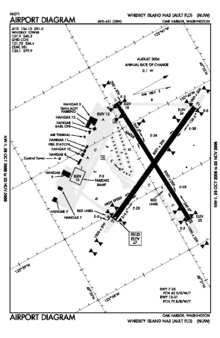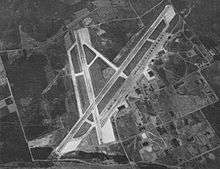Naval Air Station Whidbey Island
| NAS Whidbey Island Ault Field | |||||||||||||||
|---|---|---|---|---|---|---|---|---|---|---|---|---|---|---|---|
|
NAS Whidbey viewed from the WSW | |||||||||||||||
| Summary | |||||||||||||||
| Airport type | Military: Naval Air Station | ||||||||||||||
| Operator | United States Navy | ||||||||||||||
| Location | Oak Harbor, Washington | ||||||||||||||
| In use | 1942–present | ||||||||||||||
| Commander | Captain Geoff Moore, USN | ||||||||||||||
| Elevation AMSL | 47 ft / 14 m | ||||||||||||||
| Coordinates | 48°21′07″N 122°39′21″W / 48.35194°N 122.65583°W | ||||||||||||||
| Website | www.cnic.navy.mil/... | ||||||||||||||
| Runways | |||||||||||||||
| |||||||||||||||


Naval Air Station Whidbey Island (NASWI) (IATA: NUW, ICAO: KNUW, FAA LID: NUW) is a naval air station of the United States Navy located on two pieces of land near Oak Harbor, on Whidbey Island, in Island County, Washington.
The main portion of the base, Ault Field, is about three miles north of Oak Harbor. The other section, called the Seaplane Base for the PBY Catalina flying boats once based there, holds most of the island's Navy housing as well as the air station's main Navy Exchange and DeCA Commissary. The NASWI commanding officer also has command of a lightly used satellite airfield, Naval Outlying Landing Field (NOLF) Coupeville, on central Whidbey Island at 48°11′24″N 122°37′48″W / 48.19000°N 122.63000°W, roughly nine miles south of Ault Field. Primarily used for Field Carrier Landing Practice (FCLP) by carrier-based jets, this field has no permanently assigned personnel.
NASWI supports the MH-60S Seahawk helicopter and the EA-18G Growler, P-3C Orion, P-8 Poseidon, EP-3E ARIES II and C-40 Clipper fixed-wing aircraft.
History
1940s
On 17 January 1941, almost 11 months before the U.S. entered World War II, the Office of the Chief of Naval Operations asked the Commandant of the 13th Naval District to find a location to re-arm and refuel Navy patrol planes defending Puget Sound. Lake Ozette, Indian Island, Keystone Harbor, Penn Cove and Oak Harbor were considered and rejected because of mountainous terrain, bluff shore front, inaccessibility, the absence of sufficient beaches, and lee shores. Within 10 days, the commanding officer of Naval Air Station Seattle (NAS Seattle) recommended the site of Saratoga Passage on the shores of Crescent Harbor and Forbes Point as a base suitable for seaplane takeoffs and landings under instrument conditions. A narrow strip of land tied Oak Harbor to what is now Maylor’s Point Capehart Housing. Dredging, filling, and running water and power lines to the city were underway at the end of November when the word came to find a land plane site.
On December 8, three workers started a topographic survey of what would become Ault Field, about four miles to the north. Construction of Ault Field started on 1 March 1942. The first plane landed there on 5 August, when Lieutenant Newton Wakefield, a former civil engineer and airline pilot, who later became the air station's Operations Officer, brought his SNJ single-engine trainer in with little fanfare. Everyone was busy working on the still-incomplete runway.
On 21 September 1942, the air station's first commanding officer, Captain Cyril Thomas Simard, read the orders placing the field in use as a Navy facility. U.S. Naval Air Station Whidbey Island was duly commissioned. A year later, on 25 September 1943, the land plane field was named Ault Field, in memory of Commander William B. Ault, missing in action in the previous year's Battle of the Coral Sea. Following the recommendation of the Interdepartmental Air Traffic Control Board, an area 2½ miles southeast of Coupeville was approved as an auxiliary field to serve NAS Seattle. Survey work began in February 1943, and work started in March. Outlying Field (OLF) Coupeville was in use by September.
At Ault Field, the earliest squadrons of aircraft were Grumman F4F Wildcats, which came aboard in 1942, followed by Grumman F6F Hellcats. Later that year, Lockheed PV-1 Venturas arrived for training. By the end of 1943, all F4F Wildcats were gone, replaced by the F6F Hellcat. In 1944, Douglas SBD Dauntless dive-bombers became the predominant aircraft at Ault Field, while at the Seaplane Base, several Consolidated PBY Catalina and Martin PBM Mariner seaplanes were aboard in the summer of 1944, augmented by a few land-based Martin B-26 Marauders that arrived earlier that year to be used for towing targets.
After World War II, operations slowed and the station was placed on reduced operating status. Many naval air stations across the United States were closing because they couldn’t meet the requirements on post-war Naval aviation; 6,000-foot runways were now the minimum standard and approach paths had to be suitable for radar-controlled approaches in any weather. Lockheed P2V Neptune patrol bombers, which arrived in the late 1940s, would eventually make up six patrol squadrons at NAS Whidbey.
1950s
The Korean War restored NAS Whidbey to life and expansion and construction accelerated. Patrol Squadron FIFTY (VP-50) moved from NAS Alameda, California, in June 1956, returning seaplanes to NAS Whidbey. Flying the Martin P5M-2 Marlin, patrol squadrons dominated the Seaplane Base until the late 1960s along with the seaplane tender, USS Salisbury Sound.
During the Korean War, patrol plane activity was stepped up again with several Naval Air Reserve units being called up and redesignated as active duty squadrons. By the end of the war, there were six VP (Patrol) squadrons and two Fleet Air Support squadrons based at Whidbey. In 1955, VP-29 returned from a deployment to the Pacific and was redesignated as Heavy Attack Squadron Two (VAH-2), the first heavy attack squadron on the West Coast, the "heavy" designation reflecting its concentration on nuclear weapons delivery. Later that year, it moved to NAS North Island in San Diego to switch to the Douglas A-3D Skywarrior.
In 1958, the Heavy Attack Squadron Six (VAH-6) ("Heavy-6") Fleurs, moved from NAS Moffett Field, California, where they had been the Navy's second nuclear attack squadron. As part of CVG-61/CVW-6, the squadron then made several WestPac deployments aboard the USS Ranger (CVA-61) prior to transferring to CVW-8 for operations in the Mediterranean aboard the USS Forrestal (CV-59). Transferred to NAS Sanford, Florida, VAH-6 was redesignated Heavy Reconnaissance Squadron Six (RVAH-6) in September 1965, beginning the squadron's transition to the A-5 Vigilante.
1960s
In early 1965, patrol squadrons began to leave NAS Whidbey; VP-47 transferred to NAS Moffett Field, California and VP-17 to NAS Barbers Point, Hawaii. In July 1969, the patrol community appeared to be reviving with the delivery of the Lockheed P-3 Orion as a replacement for the venerable Lockheed P-2 Neptune, but in September 1969, VP-2 and VP-42 were deactivated.
1970s
On 1 March 1970, VP-1 transferred to NAS Barbers Point, ending seaplane patrol operations by active forces at NAS Whidbey Island. This also brought Fleet Air Wing Four to an end on 1 April 1970, leaving Patrol Squadron Sixty-nine (VP-69), a Naval Air Reserve squadron, as the sole remaining maritime patrol squadron at NAS Whidbey Island. Then in the 1970s and beyond, 16 Grumman A-6 Intruder squadrons were based at NAS Whidbey Island. Whidbey was now the West Coast training and operations center for these all-weather, medium attack bomber squadrons. In October 1970, Heavy Attack Squadron 10 (VAH-10) was redesignated Tactical Electronic Warfare Squadron 129 (VAQ-129), the Navy’s first Northrop Grumman EA-6B Prowler squadron and the sole fleet replacement squadron for Navy and Marine Prowler crews. With the exception of a forward deployed EA-6B squadron at NAF Atsugi, Japan and a sole Naval Air Reserve EA-6B squadron (VAQ-209) at Andrews AFB / NAF Washington, Maryland, NAS Whidbey Island supports all of the U.S. Navy’s Prowler squadrons.
1990s
In late 1993, with the pending closures of NAS Moffett Field, California, and NAS Barbers Point, Hawaii, additional P-3C Orion maritime patrol aircraft came aboard NAS Whidbey Island, along with the associated staffs of Commander, Patrol Wings, U.S. Pacific Fleet (COMPATWINGSPAC) and Commander, Patrol Wing TEN (COMPATWING 10). With the closure of NAS Agana, Guam, Fleet Air Reconnaissance Squadron ONE (VQ-1) also arrived at NAS Whidbey Island in 1994 with its Lockheed EP-3E Aries II aircraft. VQ-1 was placed under the clemency of COMPATWING 10 and the wing was redesignated Commander, Patrol and Reconnaissance Wing TEN (COMPATRECONWING 10). With the disestablishment of Reserve Patrol Wing, VP-69 was also placed under COMPATRECONWING 10.
In 1997, the last Pacific-based A-6E Intruder squadron, the VA-196 "Milestones", was decommissioned after a lengthy deployment for WESTPAC 1996. AMSCMC Command Master Chief Sean Miner blew the final Bosun's whistle and all plank owners from this squadron were reassigned to their new duty stations.
2000s
In July 2009, VAQ-129 accepted its first Boeing EA-18G Growler aircraft. Based on the Boeing F/A-18F Super Hornet, the Growler has replaced the Navy's EA-6Bs.
Present day
In all, there are 17 active duty squadrons and 3 Ready Reserve squadrons based at NAS Whidbey Island. The air station also maintains a Search and Rescue Unit that flies two Sikorsky MH-60S Nighthawks. With the addition of the MH-60S, Navy Search and Rescue provides 24-hour day and night maritime, inland and mountainous rescue support for Department of Defense personnel and the greater Pacific Northwest community. The SAR Unit provides 15-minute alert coverage Monday through Thursday from 0800-0200 or last plane on deck, Friday 0800-2200 or last plane on deck and 30-minute alert coverage at all other times of the year. Additionally, SAR has organic SAR Medical Technicians on all missions it performs. NASWI SAR primarily serves military aircrews, but missions to help civilians in distress are often approved and executed.
Over 50 tenant commands are at NAS Whidbey Island to provide training, medical and dental, and other support services, including a Marine Aviation Training Support Group (MATSG) for Whidbey’s staff and student Marine Corps personnel. The base also continues its longstanding role as a center of activity for Naval Air Reserve operations and training in the region.
Tenant squadrons
| Electronic Attack Squadron | Maritime patrol | Fleet Air Reconnaissance Squadron | Fleet Logistics Support | Search and Rescue |
|---|---|---|---|---|
|
|
|
See also
References
- ↑ FAA Airport Master Record for NUW (Form 5010 PDF), retrieved 2007-03-15
- ↑ Naval Air Station Whidbey Island (official site)
- ↑ http://vaq138.ahf.nmci.navy.mil/index.htm
- ↑ "390th Electronic Combat Squadron". www.cnic.navy.mil. Retrieved 2016-06-28.
External links
- Naval Air Station Whidbey Island Official
- NAS Whidbey Island at GlobalSecurity.org
- EODMU Eleven Website
- FAA Airport Diagram (PDF), effective August 17, 2017
- FAA Terminal Procedures for NUW, effective August 17, 2017
- Resources for this U.S. military airport:
- FAA airport information for NUW
- AirNav airport information for KNUW
- ASN accident history for NUW
- NOAA/NWS latest weather observations
- SkyVector aeronautical chart for KNUW

